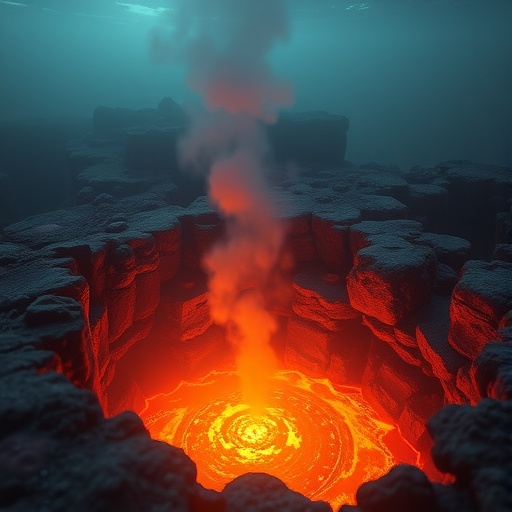In a groundbreaking study published in the Journal of the American Chemical Society, scientists have recreated laboratory conditions simulating Earth’s primordial environment roughly 4 billion years ago, revealing critical chemical reactions that may have paved the way for life’s emergence. By mimicking the natural electrochemical gradients characteristic of submarine hydrothermal vents, researchers demonstrated that essential carbon fixation reactions can occur without enzymes, supported solely by the interplay of pH, temperature, and redox potential gradients. This discovery significantly bolsters the theory that hydrothermal vents were crucial crucibles for life’s molecular origins.
Hydrothermal vents, found deep beneath ocean waters, spew out hot, alkaline fluids that differ starkly from the surrounding colder, slightly acidic seawater of the early Earth. These contrasting physical-chemical environments create natural gradients and voltages across mineral interfaces—factors analogous to modern cellular bioenergetic processes. The study’s senior author, Thiago Altair Ferreira, who holds a PhD from the University of São Paulo and currently researches at RIKEN in Japan, explains that these gradients generate voltages comparable to those observed across mitochondrial membranes, serving as a chemical “battery” to drive molecular transformations.
The venture into simulating prebiotic chemistry revolved around reproducing these hydrothermal vent conditions on a bench scale. The team engineered reactors mimicking the interaction of iron-nickel-sulfur-rich mineral walls—essentially the catalytic surfaces akin to enzyme active sites—with steep gradients of temperature and pH. Such gradients exist naturally where hot, basic vent waters mix with colder acidic ocean waters. These minerals serve as electron conductors, enabling proto-metabolic reactions as electrons flow between reducing and oxidizing agents.
Results were striking: in the absence of biological catalysts, micromolar amounts of formic acid and acetic acid were produced on the “oceanic” side of the experimental setup. This formation evidences the coupling of hydrogen oxidation on the “hydrothermal” side to carbon dioxide reduction akin to the initial steps of the ancient Wood-Ljungdahl pathway. This biochemical route, found in extant methanogenic and acetogenic microbes, converts CO2 into acetyl-CoA, a fundamental molecule in energy and carbon metabolism across life forms, and may reflect some of Earth’s earliest metabolic processes.
The Wood-Ljungdahl pathway’s significance lies not only in its antiquity but in its energy efficiency, utilizing hydrogen as an electron source to fix carbon dioxide. The study illuminated that the most energy-demanding aspects—transforming CO2 to formic acid followed by conversion to acetic acid—can be driven by geological electrochemical gradients and mineral catalysts without enzymatic input. This insight offers a compelling chemical foundation for proto-metabolism long before cellular life existed.
Ferreira emphasizes the role of minuscule electrical currents, measured in nanoamperes, to sustain these reactions. Such currents would have been continuously generated in the natural environment of hydrothermal vent systems, further validating that minimal but persistent energy flows could sustain the earliest metabolic activities. This finding challenges the notion that large energy inputs or complex enzymes were necessary at life’s inception, pointing instead toward a steady state of geochemical energy supply.
Importantly, these findings contribute new support to the “alkaline hydrothermal vent hypothesis” for the origin of life, which posits that life arose in the chemically dynamic interfaces of these vents. Here, nature’s own gradients—pH, redox potential, and temperature—organized matter into ordered, energy-rich compounds. Ferreira summarizes this as a system where life’s initial conditions emerge not from random organic soups, but from structured and sustained energy exchanges driven by geochemical gradients and mineral surfaces mimicking enzyme centers.
Beyond the origins of life, the implications extend toward astrobiology, offering viable models for life-supporting chemistry under extraterrestrial ocean conditions. Moons such as Europa and Enceladus, with suspected ocean worlds and hydrothermal activity, might host analogous electrochemical settings capable of driving carbon fixation and chemical complexity without biological intervention. This cross-planetary perspective opens new avenues in the search for life beyond Earth.
Technological innovation may also benefit from this research. Since iron-sulfur and nickel-containing minerals mimic enzymatic catalytic sites, developing stable, efficient electrocatalysts inspired by these ancient minerals could revolutionize sustainable energy solutions. Applications include improved hydrogen production and strategies for reducing atmospheric CO2 through electrochemical means, critical endeavors in addressing modern climate challenges.
This multi-institutional project, conducted by researchers from Brazil, Japan, the United Kingdom, and the United States, highlights the transdisciplinary nature of modern electrocatalysis research. The strong support from the São Paulo Research Foundation (FAPESP) and its emphasis on international collaboration was instrumental in the success of this study. The involvement of Ferreira’s doctoral advisor, Professor Hamilton Varela, further underscores the project’s academic lineage and robust experimental foundation.
Ultimately, this research redefines the chemically plausible pathways by which life’s first molecular building blocks may have formed in Earth’s ancient past. By demonstrating that simple mineral surfaces and naturally occurring gradients could drive transformative reactions, the study advances our understanding of early Earth geochemistry, offering a compelling glimpse into the bridge between geology and biology.
Thiago Altair Ferreira’s pioneering work not only shakes long-held assumptions about life’s origins but paves the way for future explorations into sustainable technologies and the search for life in our solar system. The revelation that life’s chemical foundation was built upon gradients generated by Earth’s own heated vents brings us one step closer to unraveling the profound mystery of our own beginnings.
Subject of Research: Origin of life chemistry, proto-metabolism, hydrothermal vent geochemistry
Article Title: Carbon Reduction Powered by Natural Electrochemical Gradients under Submarine Hydrothermal Vent Conditions
News Publication Date: 29-Jul-2025
Web References: https://doi.org/10.1021/jacs.5c01948
References: Journal of the American Chemical Society, DOI: 10.1021/jacs.5c01948
Image Credits: (No image provided)
Tags: alkaline hydrothermal fluidscarbon fixation without enzymeselectrochemical gradients in biologyhydrothermal vent ecosystemsmolecular precursors of lifeorigins of life researchprebiotic chemistry simulationsprimordial environment chemical reactionsredox potential in early EarthThiago Altair Ferreira researchunderwater thermal ventsvolcanic oceanic environments





